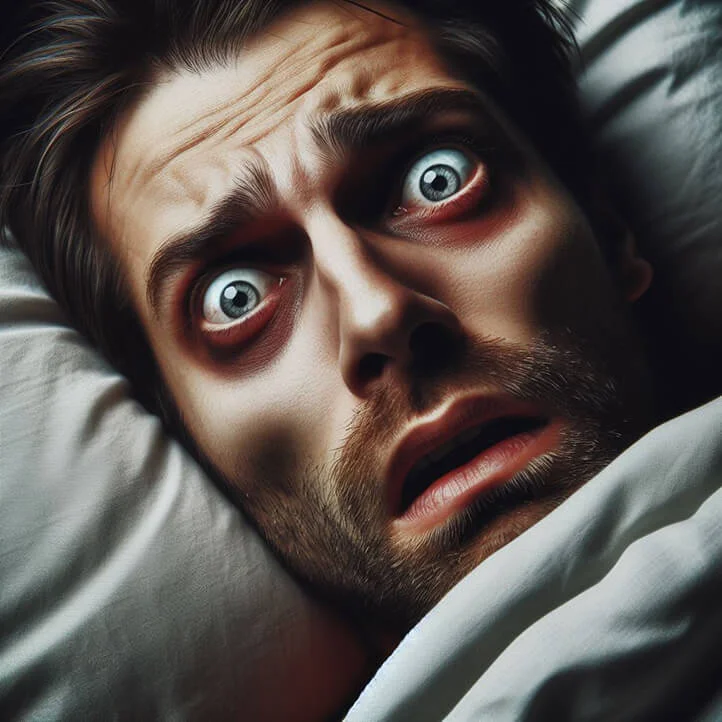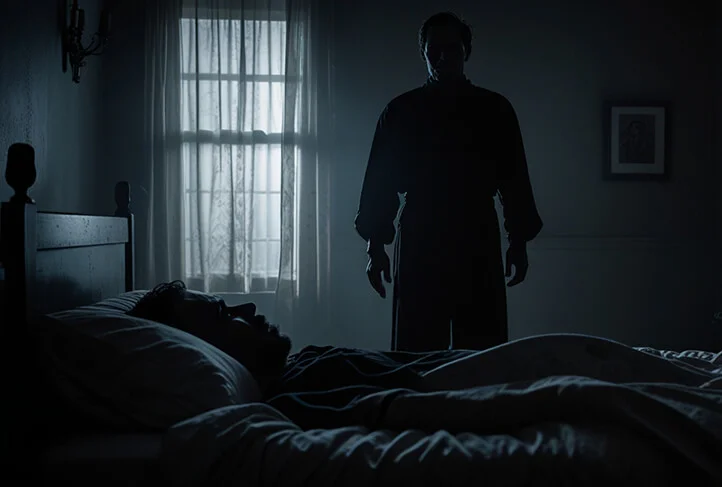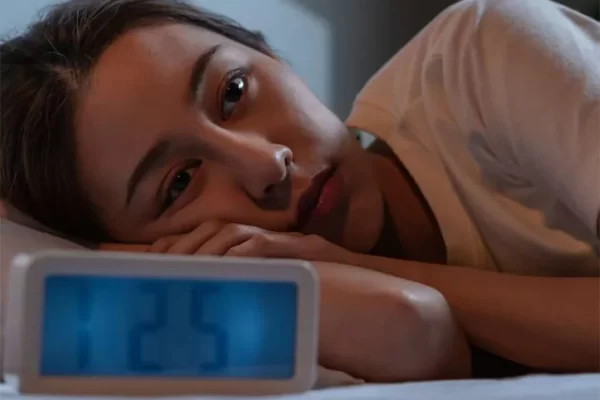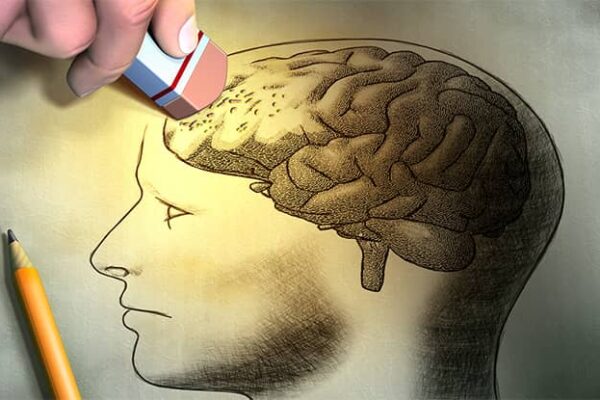Imagine the situation: you wake up or are about to fall asleep but suddenly realize you can’t make a sound or move. You are fully aware of what’s happening around you, but your body feels paralyzed. For many people, this is a frightening and anxious experience known as sleep paralysis.
Sleep paralysis is a temporary condition where a person is unable to move or speak after waking up or, less commonly, before falling asleep. While it often induces intense fear and anxiety, especially during the first experience, sleep paralysis is not harmful and is a relatively common phenomenon that affects people of all ages and cultures.

Causes of Sleep Paralysis
Sleep paralysis is a mysterious phenomenon that at first glance appears to be a frightening and inexplicable event. However, there are physiological reasons behind this condition rooted in the very nature of human sleep. Understanding these causes allows us to view sleep paralysis from a rational perspective and dispel many of the fears and myths associated with it.
One of the main causes of sleep paralysis is an imbalance of certain chemicals in the brain, such as serotonin, norepinephrine, and gamma-aminobutyric acid (GABA). These neurotransmitters play a key role in regulating sleep-wake cycles as well as rapid eye movement (REM) sleep, during which dreams usually occur. Any disruption in their production or distribution can lead to a mismatch between different phases of sleep and trigger paralysis.
Another important factor contributing to sleep paralysis is the presence of structural or functional abnormalities in certain areas of the brain responsible for the transitional processes between sleep and wakefulness. For example, deviations in the functioning of the brainstem, hypothalamus, or reticular formation can disrupt normal synchronization between the cortex and subcortex, potentially triggering paralytic episodes.
Additionally, there are several other factors that may contribute to the development of this phenomenon:
Sleep-wake cycle disruption
-
- Irregular sleep schedule. Frequent changes in sleep and wake patterns disrupt the body’s natural cycles, increasing the risk of sleep paralysis.
- Lack of sleep or excessive fatigue. Chronic sleep deprivation or physical/emotional exhaustion can cause short-term paralysis.
- Sleep disorders. Conditions such as insomnia, sleep apnea (breathing pauses during sleep), restless legs syndrome, and narcolepsy (sudden sleep attacks) often provoke sleep paralysis.
Stress and anxiety conditions
-
- High levels of stress and anxiety. Chronic stress negatively affects sleep quality and disrupts natural cycles, raising the likelihood of sleep paralysis.
- Anxiety disorders. People with generalized anxiety disorder, post-traumatic stress disorder (PTSD), panic attacks, or obsessive-compulsive disorder are prone to more frequent episodes of paralysis.
Sleep schedule disruption
-
- Shift work or night shifts. Constant changes in sleep and wake cycles can severely disrupt the body’s internal rhythms and trigger sleep paralysis.
- Time zone changes. Traveling across several time zones causes desynchronization of internal biological rhythms, which may also lead to paralysis episodes.
Other risk factors
-
- Taking certain medications. Some antidepressants, sleeping pills, sedatives, and other drugs may increase the risk of sleep paralysis as a side effect.
- Alcohol and drug use. The abuse of psychoactive substances negatively impacts sleep quality and can provoke episodes of paralysis.
- Physical or emotional exhaustion. Severe fatigue, overwork, and stress can disrupt normal sleep cycles and cause sleep paralysis.
- Genetic predisposition. There is evidence that sleep paralysis may have a hereditary component and be passed down through generations.
Understanding the causes and risk factors can help you take preventive measures to avoid recurring episodes of sleep paralysis. Eliminating or controlling these factors will significantly reduce the likelihood of its occurrence.

Sleep Paralysis: Signs, Symptoms, and Experiences
Sleep paralysis is characterized by a number of specific symptoms that can cause intense emotional experiences and feelings of fear. The main symptoms include:
- Temporary immobility and muteness. The primary sign of sleep paralysis is the complete inability to move or make any sounds for several seconds to a few minutes. During this time, the person remains fully conscious and aware of what is happening around them.
- Sensation of another presence. Many people experience an extremely realistic sensation that someone or something else is in the room during sleep paralysis. This feeling is often described as frightening or oppressive and may be accompanied by panic or anxiety.
- Hallucinations of various types. While in a state of sleep paralysis, some people may experience vivid and realistic hallucinations:
- Visual hallucinations: visions of shadows, figures, faces, or shapes in the room.
- Auditory hallucinations: perceptions of voices, screams, noises, or other sounds that are not actually present.
- Tactile hallucinations: sensations of touches, pressure, or something on the body.
- Feelings of fear, panic, and helplessness. Intense fear, terror, helplessness, and panic are some of the most common emotional experiences during sleep paralysis. This is caused by the inability to control the situation and the temporary immobility.
- Difficulty breathing. Some people may experience shortness of breath or suffocation during a sleep paralysis episode, although their breathing is not actually impaired. This sensation is caused by the temporary paralysis of the respiratory muscles, which is a normal occurrence during REM sleep.
The combination of these symptoms can create a nightmarish and frightening experience. However, it is important to understand that sleep paralysis is a temporary and harmless condition that resolves on its own after full awakening or falling asleep.
The intensity and number of symptoms can vary from person to person and from episode to episode. Some people experience only isolated manifestations, while others experience the full spectrum of sleep paralysis symptoms.

Physiological Processes During Sleep Paralysis
Sleep paralysis is a condition in which our consciousness is trapped between two worlds: reality and sleep. At this moment, unique physiological processes are triggered in the brain, which help explain the causes of paralysis and its characteristic symptoms. Understanding these processes is important for overcoming the anxiety associated with this phenomenon.
During sleep paralysis, there is a temporary shutdown of so-called “interneurons” in the brainstem. These neurons typically act as a kind of “gateway,” regulating the flow of information between the cerebral cortex (responsible for consciousness) and the spinal cord (controlling body movements). When these neurons shut down, the connection between consciousness and the body is disrupted for a short time, leading to the inability to move while being fully aware of the surrounding environment.
Another important physiological process characteristic of sleep paralysis is the excessive activation of the amygdala—the area of the brain responsible for processing fear and anxiety emotions. This can explain the intense feelings of horror and panic that often accompany paralytic episodes. In addition, overstimulation of the visual, auditory, and somatosensory cortex can result in vivid hallucinations of various types.
To understand what happens during sleep paralysis, we must consider the phases of sleep and their physiological characteristics.
Sleep Phases
Our sleep consists of cycles that include two main phases: rapid eye movement (REM) sleep and non-REM sleep.
- REM sleep (rapid eye movement). During this phase, the brain is highly active, and we experience vivid dreams. However, the body is temporarily paralyzed to prevent the physical enactment of dreams. This natural mechanism protects us from involuntary movements during sleep.
- Non-REM sleep is characterized by deeper sleep and less brain activity. Dreams can also occur in this phase, but they are less vivid and memorable.
Processes Leading to Sleep Paralysis
Sleep paralysis occurs when the brain and body are out of sync during the transition between sleep and wakefulness. Two main scenarios are possible:
- The brain “wakes up” before the body. In this case, consciousness is already awake, but the body is still paralyzed, as in REM sleep. The person is aware of their surroundings but cannot move or speak.
- The body “wakes up” before the brain. Here, the body emerges from the paralyzed state of REM sleep, but consciousness is still “asleep” and generating hallucinations or the feeling of the presence of other objects/people.
In both cases, there is a temporary disconnect between brain activity and the body, leading to the symptoms of sleep paralysis.
The hallucinations and sensations associated with sleep paralysis can also be explained by the activity of certain areas of the brain during REM sleep:
- The visual cortex is activated, resulting in visual hallucinations.
- The auditory regions are involved, leading to auditory hallucinations.
- Areas responsible for emotions and the feeling of fear are hyperactive, producing intense experiences of horror.
- Paralysis of the respiratory muscles can create the sensation of breathlessness.
Thus, sleep paralysis is a result of normal physiological processes during sleep but in a situation where the brain and body are not fully synchronized during the transition between states.

Prevalence of Sleep Paralysis
Sleep paralysis is a fairly common phenomenon, and anyone can be affected, regardless of age, gender, or ethnicity. However, some populations are at higher risk of developing this condition:
- Students and young people. Due to irregular sleep patterns, stress, and frequent changes in daily routines.
- People with sleep disorders. Such as insomnia, sleep apnea, restless legs syndrome, or narcolepsy.
- Individuals with anxiety and mental disorders. Including generalized anxiety disorder, PTSD, panic attacks, clinical depression, and other conditions.
Researchers estimate that about 8% of the population experiences sleep paralysis regularly (several times a year or more), and 60-70% of people experience at least one episode of sleep paralysis in their lifetime.
The duration of each individual episode of sleep paralysis varies, but they usually last less than a minute. The most common duration is between 20 seconds and 2 minutes. However, in rare cases, paralysis can last longer – up to 15-20 minutes.
Some people experience sleep paralysis regularly, while others experience it sporadically, with long breaks in between. The frequency of episodes depends on individual risk factors, such as sleep patterns, stress levels, and the presence of related disorders.

Cultural Aspects and Folklore
Although sleep paralysis has a scientific explanation today, in the past, this phenomenon was often associated with mystical or supernatural forces in various cultures and civilizations. References to sleep paralysis can be found in ancient texts, folklore, and legends of many peoples around the world.
- In some cultures, sleep paralysis was attributed to the presence of evil spirits, demons, or supernatural beings that supposedly “pressed” on the chest of the sleeping person, depriving them of the ability to move.
- In medieval Europe, sleep paralysis was often associated with attacks by witches or the devil, who were thought to “steal” the sleeper’s soul.
- In some regions of Asia and the Americas, there were beliefs in “night demons” or “nightmare creatures” that visited people during sleep, causing paralysis.
- In Islamic culture, sleep paralysis was sometimes attributed to the influence of jinn—supernatural beings mentioned in the Quran.
- Among several indigenous peoples of North America and Australia, there were legends of “sleep spirits” that could harm a person during the borderline states between sleep and wakefulness.
Many of these ancient beliefs and myths were attempts to explain the frightening phenomenon of sleep paralysis with the limited information people had at the time. Today, thanks to scientific research, we understand that sleep paralysis has entirely natural physiological causes.
Nevertheless, some people, especially in specific cultural circles, may still associate their experience of sleep paralysis with mystical or paranormal phenomena. It’s important to respect these beliefs but also provide scientific information for a better understanding of this phenomenon.

Impact and Consequences of Sleep Paralysis
Although sleep paralysis itself does not pose an immediate threat to physical health, it can have a negative impact on sleep quality, emotional state, and daily life:
- Sleep disruption: Repeated frightening episodes can cause difficulty falling asleep due to fear of experiencing paralysis again. This can lead to chronic sleep deprivation and related problems.
- Anxiety and fear: The aftermath of the terror experienced during sleep paralysis can manifest as feelings of anxiety, fear, and worry even after the episode has passed.
- Depression and PTSD: In rare cases, sleep paralysis can trigger the development of depression or post-traumatic stress disorder, especially if the episodes are extremely frightening and traumatic.
- Exhaustion and stress: Disrupted sleep, constant worry, and anxiety can lead to physical and emotional exhaustion and significantly increase stress levels.
- Disruption of daily functioning: In some cases, anxiety and fears associated with sleep paralysis can negatively affect work performance, concentration, social interactions, and other important aspects of daily life.
- Relationship problems: A lack of understanding and information about sleep paralysis can cause tension and conflicts with loved ones, partners, or family members.
It’s important to note that the severity of the consequences varies greatly from person to person. Many people experience rare episodes without any serious long-term issues. However, if paralysis becomes a frequent occurrence and is accompanied by significant stress, anxiety, or sleep disturbances, it is recommended to seek help from a specialist.

How to Avoid Sleep Paralysis?
There are effective ways to avoid sleep paralysis, manage it, or reduce the likelihood of its recurrence. Key strategies include maintaining a healthy sleep schedule, managing stress, and using specific techniques to exit the paralysis state.
Sleep Schedule Management
Since disruption of the sleep-wake cycle is one of the main causes of sleep paralysis, it is crucial to follow healthy sleep habits:
- Stick to a regular sleep routine, aiming to go to bed and wake up at roughly the same time each day.
- Ensure you get enough sleep hours recommended for your age group (usually 7-9 hours for adults).
- Create a conducive sleep environment: keep your bedroom cool, dark, and quiet.
- Avoid using electronic devices (smartphones, tablets, PCs) right before bedtime, as their light can disrupt sleep cycles.
- Maintain a stable sleep routine even on weekends to avoid abrupt changes in biological rhythms.
Stress Management
Since stress and anxiety are risk factors for sleep paralysis, it’s important to learn how to manage these conditions effectively:
- Practice relaxation techniques such as meditation, yoga, breathing exercises, or progressive muscle relaxation.
- Make time for hobbies, physical activities, and other stress-relieving activities.
- Keep a journal to write down your thoughts and feelings—this can help reduce anxiety.
- Talk to loved ones or a professional (psychologist, therapist) about your problems and fears related to sleep paralysis.
- Consider learning cognitive-behavioral therapy techniques to manage anxiety states.
How to Exit a Sleep Paralysis Episode?
There are specific techniques that can help you exit sleep paralysis:
- Focus on moving your fingers or toes—try to wiggle them, which can help “wake up” the body.
- Try to slowly roll onto your side, changing your body position.
- Tense and relax the muscles of your face and body in sequence.
- Focus on deep breathing, taking slow inhales and exhales.
- If you don’t experience numbness, call for help from household members who can help pull you out of sleep paralysis.
- Try to stay calm and not give in to panic, recognizing the temporary nature of this state.
Other Recommendations
- Avoid working night shifts or on a rotating schedule if possible, as they can significantly disrupt natural sleep and wake cycles.
- Limit alcohol and psychoactive substances, especially before sleep, as they can provoke episodes of sleep paralysis.
- Regularly engage in physical exercises and maintain a balanced diet to improve overall well-being, reduce stress, and optimize sleep cycles.
- Consult a therapist or sleep specialist if sleep paralysis becomes a frequent occurrence or is accompanied by other troubling symptoms. They can rule out other possible causes and, if necessary, prescribe appropriate treatment.
- Join support groups or forums where people share their experiences and advice on overcoming sleep paralysis. This way, you can feel less alone in your struggles.

Sleep Paralysis: Acceptance and Understanding of the Phenomenon
Although sleep paralysis can be frightening, it is important to remember that it is not a sign of any serious disease or mental disorder. It is a temporary and harmless condition that occurs due to an asynchrony between the brain and body during the transitional phases of sleep.
Acceptance and understanding of the nature of sleep paralysis help reduce the associated fear and anxiety. Knowing that it is a common phenomenon experienced by many people can bring relief and ease the anxiety associated with future episodes.
It is also important to identify personal triggers and risk factors to take appropriate measures in adjusting sleep schedules, managing stress, and addressing other potential causes.
Interesting Facts About Sleep Paralysis
- Sleep paralysis is considered a relatively common phenomenon in many cultures and civilizations throughout human history. References to it can be found in ancient texts, folklore, and legends from various peoples around the world.
- In some cultural traditions, sleep paralysis is associated with mystical or supernatural events, such as the presence of spirits, demons, or aliens. However, from a modern scientific perspective, it has natural physiological explanations.
- People experiencing sleep paralysis often describe the sensation of “choking” or “pressure on the chest.” This is due to the temporary paralysis of the respiratory muscles during the rapid eye movement (REM) phase of sleep, which, in fact, does not impair breathing.
- Studies show that sleep paralysis is more common among students, adolescents, and young people, possibly due to irregular sleep schedules, stress, and hormonal changes at this age.
- Sleep paralysis can occur both when falling asleep (hypnagogic paralysis) and upon waking (hypnopompic paralysis), with the latter being more common.
- While most people experience fear and anxiety during sleep paralysis, some describe the experience as calm, interesting, or even pleasant, without negative emotions.
- There is evidence that the ability to lucid dream (lucidity) may increase the risk of sleep paralysis, as this is also related to activity in the transitional phases of sleep.

Conclusion
Sleep paralysis is a temporary and harmless, though potentially frightening condition, caused by a mismatch between the brain and body during the transitional phases of sleep and wakefulness. Adhering to healthy sleep habits, managing stress, and understanding the nature of this phenomenon help overcome and prevent it.
If sleep paralysis becomes a frequent occurrence or is accompanied by other sleep, health, or mental health problems, it is essential to consult a doctor or sleep disorder specialist. They can identify and address possible causes and prescribe appropriate treatment if necessary. However, in most cases, sleep paralysis is not a cause for serious concern and can be successfully managed through appropriate methods and lifestyle changes.
Sleep paralysis remains a relatively understudied but widespread phenomenon that deserves more attention and understanding in society. By raising awareness of this phenomenon, we can help people better cope with it and reduce the fear and anxiety associated with this condition.




